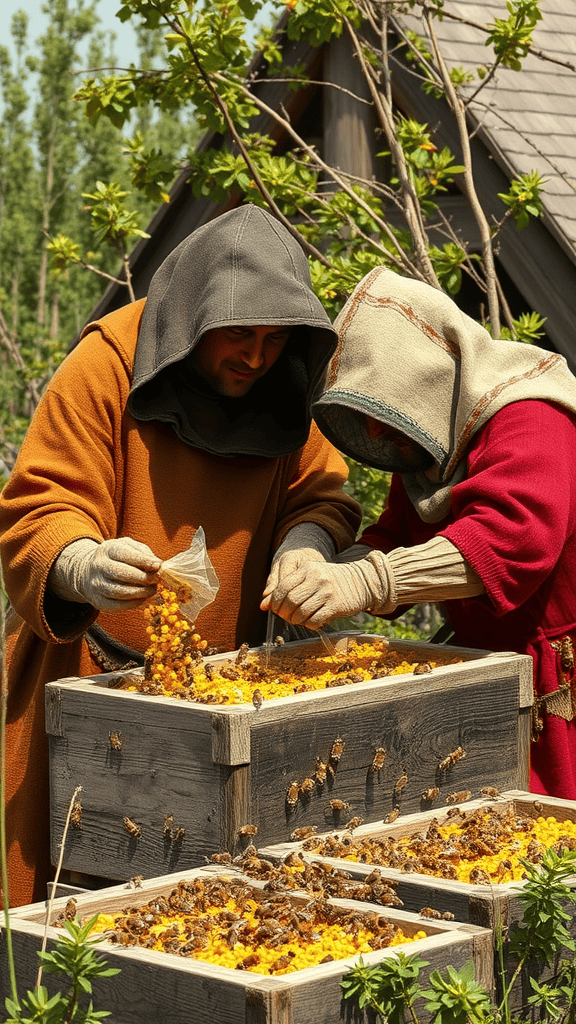An Overview of Medieval Beekeeping Practices and Techniques
Medieval beekeeping was a vibrant and essential practice during the Middle Ages, contributing significantly to agriculture and everyday life. Beekeeping not only provided honey, a vital sweetener, but also beeswax, which had various uses ranging from candle-making to waterproofing. Understanding the methods and tools used in medieval beekeeping reveals a fascinating glimpse into this intriguing aspect of history.
The Role of Bees in Medieval Society
In medieval Europe, bees were considered incredibly valuable. Honey was not just a food source; it had medicinal properties and was used in various recipes. The wax produced by bees was used for making candles, which were essential for lighting homes and churches. As a result, beekeeping was a widely practiced skill, often passed down through generations. Furthermore, bees were viewed as symbols of hard work and industry, embodying the spirit of community and cooperation.
Beekeeping Tools and Techniques
Medieval beekeepers utilized a variety of tools and techniques to manage their hives.
- Bee Hives: The most common type of hive was the skep, a dome-shaped structure made from straw or wicker. Skeps offered protection for the bees but were less convenient for harvest since they had to be destroyed to collect honey.
- Smoking Tools: Smoke was used to calm bees during harvesting. Beekeepers created smoke by burning natural materials like pine needles and dried leaves.
- Harvesting Equipment: Tools such as honey knives and sieves were crucial in the process of extracting honey. Bees had to be carefully handled to ensure minimal stress on their colony.
Seasonal Practices
Beekeeping practices varied significantly with the seasons. In spring, beekeepers often checked their hives for signs of a healthy queen and collected the first honey. Summer was the main harvesting season when beekeepers would gather honey and beeswax. It was during this period that they had to monitor the health of their hives closely to protect against pests and ensure efficient foraging.
In autumn, preparations for winter began. Beekeepers would secure the hives to protect them from the cold and pests. They might also leave extra honey for the bees to feed on during the harsh winter months. Ensuring that their colonies were well-fed could mean the difference between survival and death for the hive.
Beekeeping Communities
The art of beekeeping often brought communities together. Neighbors would share techniques and knowledge, helping each other with hive management, pest control, and honey extraction. Some communities even had dedicated beekeepers responsible for multiple hives, creating a system that ensured the sustainability of the local bee population.
Challenges in Beekeeping
Despite the benefits, medieval beekeepers faced numerous challenges. Pests like wax moths and diseases such as foulbrood could devastate hives. Additionally, harsh weather conditions often impacted foraging, making it harder for bees to collect enough food. Beekeepers needed to be observant and knowledgeable to navigate these difficulties and maintain healthy colonies.
The Cultural Significance of Bees
Beyond practical uses, bees had a special place in medieval culture. They frequently appeared in art, literature, and religious texts. The bee was often regarded as a symbol of the Church, representing diligence, cooperation, and divine gift. Such cultural associations further reinforced the importance of beekeeping in medieval life.
Legacy of Medieval Beekeeping
Medieval beekeeping set the foundation for modern practices. Techniques developed during this period influenced contemporary beekeeping, which still values sustainability and community engagement. Today, beekeeping is experiencing a renaissance, with a renewed emphasis on the importance of bees in our ecosystem. As we learn from the past, the lessons of medieval beekeepers remind us how interconnected we are with nature and the vital role bees play in our food system.
By exploring what medieval beekeeping was like, we gain insight into how these practices contribute to our daily lives and the environment now. The bees still work tirelessly, reminding us of their historical significance and inspiring future generations to protect these essential pollinators.
The Role of Honey in Medieval Society and Economy
Honey played a vital role in medieval society and the economy, much more than just a sweet treat. It was a source of sustenance, a currency of trade, and a crucial product for various industries. Let’s explore how honey influenced daily life, economy, and relationships among people in medieval times.
In the medieval period, honey was one of the few sweeteners available, especially before the widespread introduction of cane sugar in later centuries. Because of this scarcity, honey wasn’t just a foodstuff; it was treasured. People used it in various dishes, including meats, pastries, and even in beverages. Mead, fermented honey, was a popular drink among all social classes, and these beverages often played a role in celebrations, rituals, and communal gatherings.
Beyond culinary uses, honey was also an important medicinal resource. Medieval healers relied on its natural preservatives for wound treatments and its healing properties for various ailments. Honey’s antibacterial qualities made it a key ingredient in salves and ointments. People believed that honey could cure a range of illnesses, reinforcing its importance in both the home and the apothecary’s shop.
The economics surrounding honey also contributed significantly to local and regional markets. Here are several key points regarding honey’s role in the medieval economy:
- Trade Goods: Honey was widely traded, not just locally but even in international markets. The demand for honey prompted beekeeping as an agricultural practice.
- Taxes and Tithes: Many feudal lords imposed taxes on honey production, as it was seen as a valuable commodity. Peasants often took honey to market, which could help them pay their dues.
- Bartering: Honey often served as a form of currency. People traded honey for grain, livestock, or textiles, as it had intrinsic value in rural economies.
- Crafts and Industry: The raw material was essential for various crafts, including candle making. Beeswax was a highly sought-after item for creating durable, scented candles.
For farmers, beekeeping was often a side endeavor compatible with their main agricultural activities. The practice of keeping bees would not only yield honey but also promote pollination of crops, enhancing yield. Many medieval farmers would have observed that their efforts in beekeeping would lead to increased produce from their fields.
Geography also played a significant role in the honey market. Some regions were particularly famous for their honey. For instance, monastic communities, such as those in France and the British Isles, became known for their high-quality honey. Monks meticulously cared for their bee colonies, often leading the way in advanced beekeeping practices of the time. These communities not only produced honey for their own use but also for sale, impacting local economies significantly.
Socially, honey created connections among communities. Festivals often marked the harvest of honey, and medieval fairs included competitions for the best honey. Enthusiastic beekeepers would share their techniques, fostering a sense of community. These gatherings were key moments for knowledge-sharing and strengthening relationships among individuals.
The spiritual aspects of honey in medieval society cannot be overlooked either. Many believed that bees were a symbol of divine inspiration. Honey was often used in religious rituals and was considered an offering for festivities, reinforcing its cultural significance. In the Christian tradition, honey symbolized the sweetness of God’s promises and was sometimes used in baptisms and other sacred ceremonies.
Honey was much more than a simple food source in medieval times. It was interwoven into the fabric of society, enhancing culinary experiences, driving economic activities, promoting health, and fostering community bonds. Understanding its multifaceted role helps us appreciate the complexity of medieval life and the importance of even the simplest commodities.
Conclusion
Medieval beekeeping was more than just a means of producing honey; it was a vital aspect of life during the Middle Ages. The practices and techniques used in medieval beekeeping reflect a deep understanding of nature and a commitment to sustainable agriculture. Beekeepers utilized various methods, such as hollow logs and woven straw hives, to nurture their colonies. This intricate relationship between humans and bees showcased the ingenuity of medieval communities, where the art of beekeeping was passed down through generations.
Honey held significant value in medieval society, serving not just as a sweetener but also as a crucial ingredient in medicine, trade, and even religious rituals. The golden liquid was widely regarded as a symbol of wealth and prosperity, leading to a thriving economy centered around its production. Communities relied heavily on the trade of honey and beeswax, which were essential for everything from food preservation to candle making. Beekeeping played a key role in shaping social structures, with beekeepers often holding esteemed positions within their communities.
Understanding the dynamics of medieval beekeeping highlights its importance in historical context. The intricate techniques and practices developed during this time laid the foundation for modern beekeeping. Today, we continue to appreciate the vital role that bees play in our ecosystems and economies. By looking back at how medieval societies valued and nurtured bees, we gain a deeper appreciation for this remarkable practice that continues to thrive in the present day.
As an Amazon Associate, I earn from qualifying purchases.

